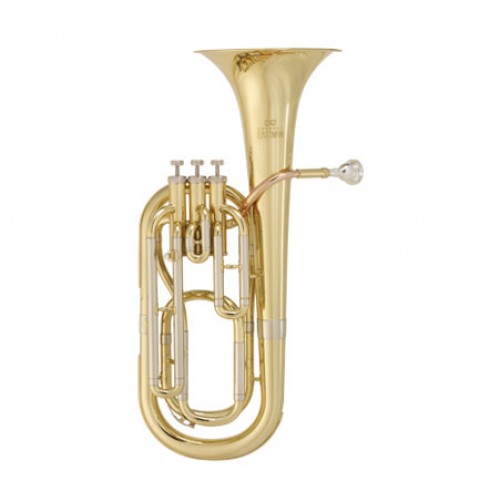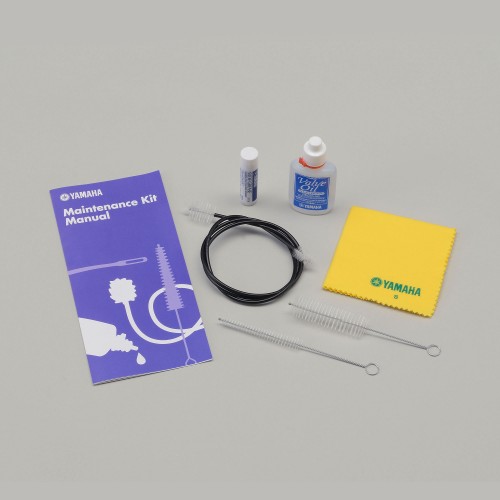Introduction
The earliest recognizable predecessor of the baritone horn was an instrument with a body that curved back and forth like a snake, thus is was known as a “serpent.” This early wood instrument also had a mouthpiece and generated very low tones. However, these instruments had no keys, only tone holes to be covered with fingers, so true chromatic playing was next to impossible.
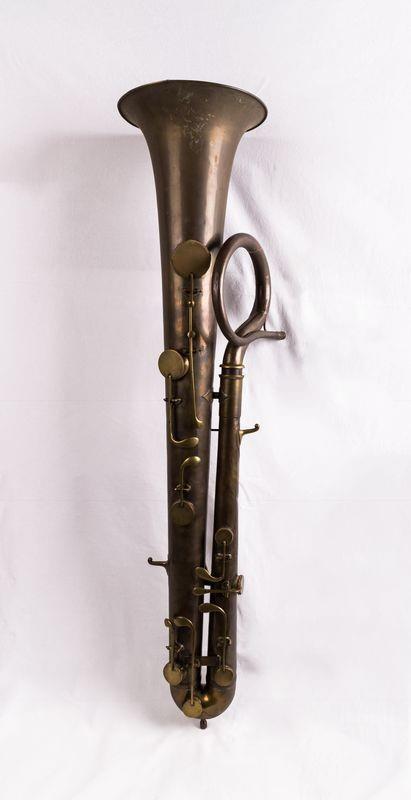
In the 1810s, Jean Hilaire Aste produced a keyed instrument crafted in brass in his Paris workshop that he called the “ophicleide.” At first, the ophicleide was seen as just a mechanical improvement to serpents and other contrabass brass and woodwind instruments, so his invention didn’t receive the respect it deserved at first. Part of this might have been due to its somewhat unusual appearance: it shared the bent-in-the-middle look of the bassoon and a curled leadpipe. However, appreciation for the quality of the instrument grew quickly and Aste received a patent on the ophicleide in 1921.
The 1830s was a period when instrument makers in Austria and Germany were experimenting widely with brass instruments, particularly in the baritone and tenor range. Other instruments in this area included saxtubas, sax trombas, Wagner tubas, contralto horns, alto horns, and valved trombones.
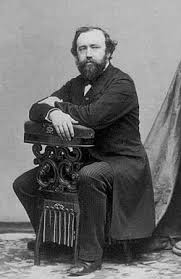
Adolph Sax, the namesake of the saxophone, made his own valved instrument in the baritone range as part of his family of “saxhorns.” This instrument was known as the baritone saxhorn and, by the 1850s, he had convinced the French military to use saxhorns exclusively in military band exercises.
The saxhorn had some important distinctions from today’s baritone horn. The tubing of the saxhorn was much less wound, so it stood a good bit taller than today’s horn. It also had a flare that appears more conical than today’s horn. This instrument was a very common sight in bands later in the 19th century.
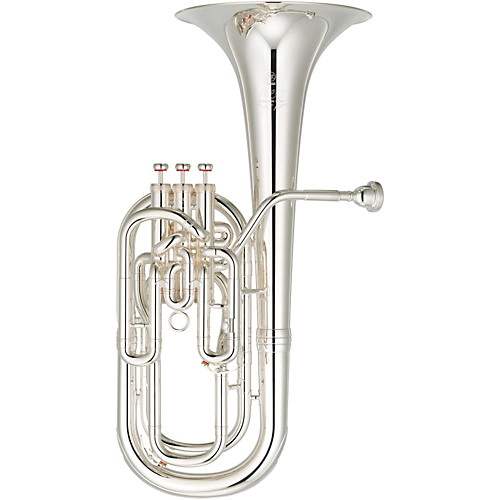
Since this time, there have been gradual improvements to the quality of the instrument in terms of intonation and playability, but there have not been major evolutionary shifts. The number of keys has come down over time to the three you now see today.
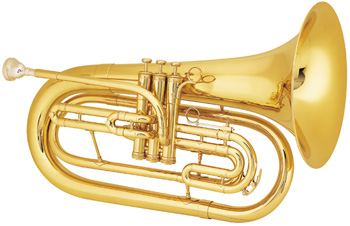
When you see a baritone used in a marching band today, you will likely see a marching version of the horn. These are constructed horizontally with a bell that projects out in front of the player like an oversized trumpet.
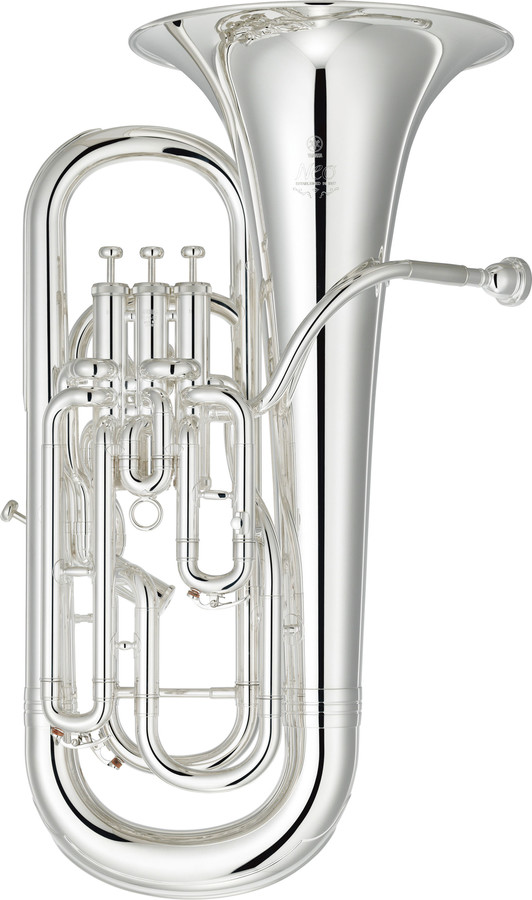
The baritone is not to be confused with the euphonium. Many people use the terms “euphonium” and “baritone” interchangeably, though this is incorrect. The two instruments look alike, but the euphonium has a larger conical bore that gently tapers out to the bell and an extra valve. The baritone has three valves and a smaller, more cylindrical bore. British models tend to have the bell pointing directly overhead, while American versions have a bell that aims forward at a slight angle.
Why Play the Baritone?
The baritone is relatively easy to learn for beginners. The deep beautiful tone from a baritone is attractive to many students who like the sound of a lower voice. Many students who like the tuba start out on the baritone with plans to switch to the tuba after a year or two of band.
Back to topWhich Baritone Should I Choose?
The Orchestra Place requires all students to have an instrument from the teacher-approved brand list to ensure the best experience and sound for the student and the ensemble.
For beginners, we recommend the Eastman Student Bb Baritone Horn.
Andreas Eastman Baritones set the standard for quality and tone and they are great for beginning students and beyond. Andreas Eastman EBH 311 Baritone Horns are in the key of Bb and have 3 top action valves with stainless steel pistons. The upright bell has a diameter of 8 3/8″ and it is constructed from hand-spun yellow brass with a wire rim and torch annealed bell tail. The mouthpipe is constructed from rose brass. The bore size is .504″ and it has a lever water key. The Instrument Place outfit includes a canvas covered case with a mouthpiece, valve oil, polishing cloth and name tag, everything your student needs for the first day of class.
When deciding to purchase, make sure you’re not buying an euphonium or alto horn, both of which look very similar to the baritone.
Back to topHow Much Should a Baritone Cost?
A student baritone will cost roughly $1000-$3000. Intermediate players can expect to pay $4,000 or more depending on the brand and model.
Back to topRent-to-Own or Lease-to-Own Baritone Options
Installment plans are an excellent option if you’re ready to make the commitment of buying an instrument but can benefit from deferred payments. This way, you get the freedom to pay over time, with the ultimate reward of owning the instrument. If you choose a rent-to-own or lease-to-own option, however, it’s important to check the fine print to make sure there are no hidden fees, and you should investigate the cancellation policy as well. Never sign up for a plan that traps you into payments if your child loses interest in playing an instrument. Look also for retailers who offer affordable damage protection during the installment term.
Our instrument supplier, The Instrument Place, offers teacher-approved instruments and one of the best interest-free lease-to-own programs as part of their commitment to getting an instrument in the hands of every person who wishes to play, without it being a financial burden.
Back to topRecommended Baritone Accessories
When buying a baritone, look for a store that offers all the accessories your child will need in order to best use and maintain it. Along with your purchase, check that a protective carrying case, mouthpiece, slide cleaning rod, lint-free polishing cloth, and slide oil are included or can be added. Some other items you could also pick up are a cleaning snake, mouthpiece brush, and tuning slide grease.
If given the option to purchase a music stand, go for it! A music stand promotes proper playing posture, which helps to prevent back aches and hunching over.
The Instrument Place instrument outfits come equipped with everything needed to get started in class, plus a free music stand with every instrument purchase!
Back to topBaritone Maintenance and Care
Valve Oil Application
- Always consult your teacher if you are not sure how to apply valve oil.
- The purpose of valve oil is to clean, lubricate and fill the air space inside the valves.
- You should oil the valves of your horn before each time you play, preferably without completely removing the valves. This will prevent accidental damage to the pistons.
- Remove the top cap and pull out the piston far enough to see the valve and apply enough oil to fully cover the surface. (Do not oil the valves from the bottom caps)
- Using too little oil will not properly lubricate your valves. Using too much oil will not cause any damage to the horn.
- Replace the valve without excessive rotation. As you lower the valve, slowly turn it clockwise until it locks into place.
- The oil will naturally distribute itself when the valves are depressed.
- Confirm that the valve has been replaced properly by blowing through the instrument.
- You will also need to apply oil to the small water key about once a month.
Slide Grease Application
- Always consult your teacher if you are not sure how to apply slide grease.
- You should grease your slide at least once a month.
- Remove slide and wipe off the old grease.
- Apply a bit of grease to one end of one of the slide tubes and re-insert this side.
- Gently rotate the slide as it is pushed in, evenly distributing the grease to all parts of the slide.
- Repeat this process with the other end of the slide tube.
- When completed, insert the slide as normal and remove all excess grease.
- NEVER use Vaseline in place of slide grease. This will corrode your horn.
Maintenance
- Your mouthpiece should not have any dents in the end of the shank. If you notice any dents in your mouthpiece you should immediately take it to a technician for repair.
- You should grease your slide at least once a month. You should move and grease all slides and bottom caps at least once a month.
- When bottom caps are removed you can apply a small amount of slide grease to the threads of the cap for easy turning.
- If the bottom caps are dirty you can wash them in warm water and let dry completely before greasing and reassembling.
- DO NOT ATTEMPT TO REMOVE THE CAPS, MOUTHPIECE OR SLIDES IF THEY BECOME STUCK. A lack of oil and grease will cause the parts of your trumpet to stick. If they do stick take it to a technician immediately for removal.
- NEVER try to remove stuck parts with pliers or hammers!
- Wipe off your fingerprints from your trumpet after every use. A clean, non-treated cotton cloth will work the best.
- If you do choose to use a treated polishing cloth be sure that it is for the proper finish. Using the wrong cloth could cause scratches.
- Always store your instrument in its case with the lid closed when not in use. This will prevent any excess tarnishing and lower the risk of damage.
- Do not put anything (including sheet music) inside the case with your instrument that does not belong. Closing the case with extra contents can cause damage to the valves or dents.
- Also, make sure that all the latches are securely closed before transporting your instrument.
Student baritone prices can be considerable so take care of your instrument.
Back to topFamous Baritone Players
Looking for more inspiration? The baritone horn is primarily a big band and jazz hall instrument (especially Latin), but it is often heard blasting from a horn section in rock and pop music as well. While classical music does not make extensive use of the baritone, it is heard on occasion. Below are sound bites from famous trombone players from all a range of music categories.
Famous classical baritone players include James Morrison, Lyndon Baglin, Herbert Scott, Alex Mortimer, Harry Mather, Leonard Falcone and Stephen Mead.
Well known jazz baritone players include Rich Matteson, Bernard McKinney, Howard Johnson, Phineas Bower, Maynard Ferguson and Billy Miller.
Back to top
